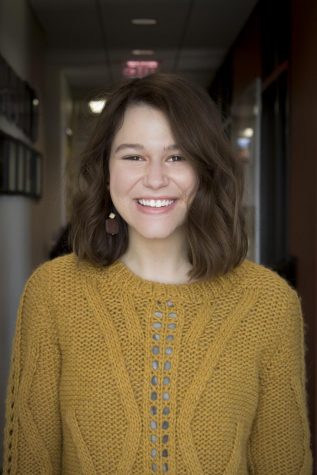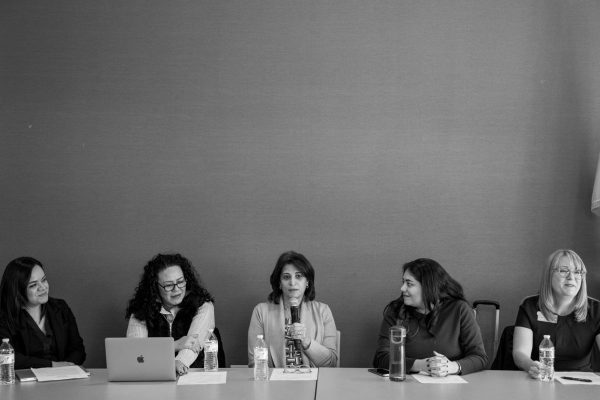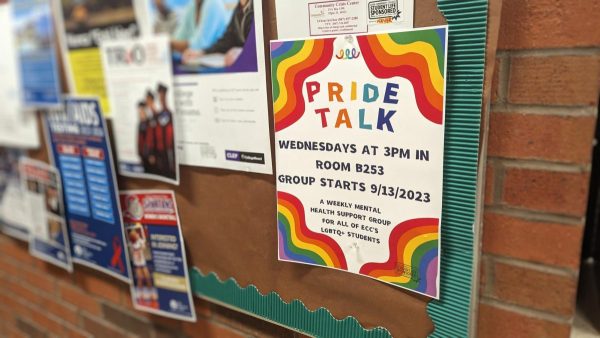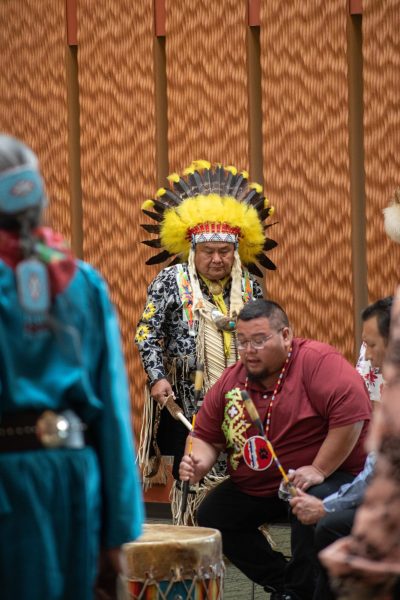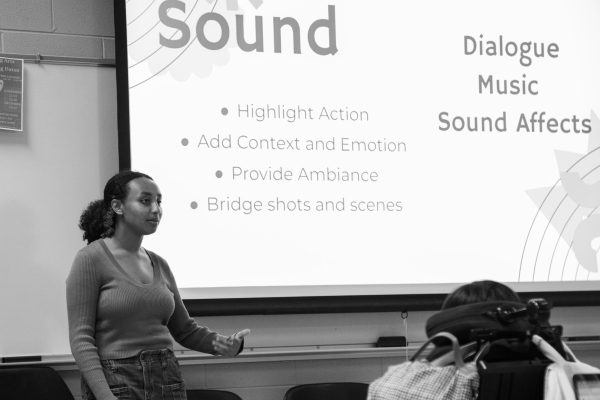You Just Gotta Be There
Young Artists in the Chicago Area and their Champions
May 15, 2018
“Music can be life-saving, to be honest,” said Kim Frost, co-founder of the teen open mic hosted at FitzGerald’s in Berwyn, Illinois and owner of Kim Frost Vocal Studios in Oak Park. “When I was in high school, I went through a really, really, very difficult and terrible time, and if I didn’t have music and theatre, I don’t know what would have happened to me. It kept me putting one foot in front of the other.”
Frost hung her head and let it bobble, pulling her blueberry scone to her edge of the small table between us and lowering her voice, as if what she was about to say was a deep, dark secret: “Being a teenager sucks; it can be really difficult, and if you don’t have a way to be yourself, what are you supposed to do?”
The open mic for young artists is held every third Sunday of the month in the sidebar of the iconic nightclub, FitzGerald’s, located only a little more than a handful of miles west of downtown Chicago. The room is always aglow with paper-mache lantern lights strung across the patterned aluminum ceiling, where the disco ball glitters just slightly off-center. In the summer months, the sun peeks through the blinds, its clementine-hue washes over the bar benches and waves its final hand just after sign-up before dipping below the horizon. At the front of the room, there’s only a small gap between the audience and the performers, like the space that parts the shore from the vast, blue sea.
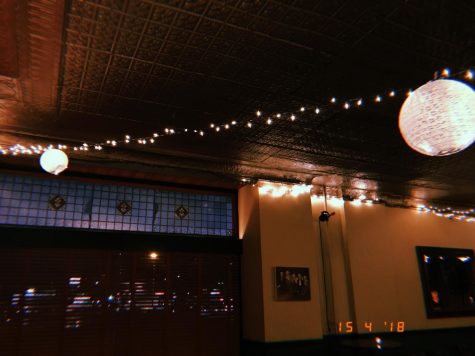
The lights are dimmed moments before the open mic at FitzGerald’s begins.
“I love how small it is,” said former Kim Frost vocal student and the current host of the open mic, Georgia Kay. “The stage isn’t elevated, so everyone is on the same platform.”
It almost seems like a metaphor for what the open mic was built on: The consistent acceptance and comradery that comes with baring one’s soul in a room largely filled with strangers. It’s such a distinct vulnerability, swaying in the spotlight as the words that you are and aren’t saying paint the walls in brand new vivid colors. For years, Frost would work toward this ideal for people who, like her, searched tirelessly for those essential outlets that either weren’t available nearby at all or lacked the inclusivity necessary to serve their ultimate purpose.
People like Iris Nosek, who performed at the inaugural open mic in 2014 at age 13 and now, will shortly be headed to college in the fall.
“I went right in with an angst-y poem I’d written,” Nosek said. “I was in eighth grade at the time and was just getting over my stage fright.”
Nosek, one rainy summer night, confidently led the audience in a plucky acoustic rendition of “A Noun is a Person, Place or Thing” from the 90s television series “Schoolhouse Rock!” The audience was simultaneously surprised and overjoyed.
“I’ve grown into music since [the first time performing,]” Nosek said. “And sometimes I struggle during my performances, but it’s such a welcoming environment.”
The open mic also felt like a sort of haven to Louise Fliegel, for whom singing in front of an audience was something she was able to comfortably ease into at FitzGerald’s.
“The first open mic I came to, I just watched and tried to decide if it was something I wanted to try,” said Fliegel. “I’ve been doing violin recitals since I was four and a few group-singing performances, but it was my first time singing by myself in front of a crowd.”
Having performed several times at FitzGerald’s, Fliegel finally feels settled in.
“It’s probably the most comfortable environment possible for people who just want to try performing in front of people,” Fliegel said. “It has a really casual and easy-going way about it: just show up, get up and go for it.”
“For me, it’s so important for young artists to be able to express themselves, to share their music and be able to come together in a sort of fellowship in that way,” Frost said. “I have, and this is going to sound so Pollyanna, but I have so much faith in [this] generation, believe it or not — I really do, because I think you guys get it.”
Before it became a staple in the lives of many young creatives in the greater Chicago area, the idea sprouted, and subsequently bloomed, in a very small and simple way. Frost, along with her self-proclaimed “sister from another mother,” Gigi Hudson, owner of Actors Garden in Oak Park, sat around Hudson’s dining room table one night in 2014 and dreamed of a place where teenagers could share their art without the fear of dismissal.
“Kim initially came up with the idea [for an open mic],” Hudson said. “She and a couple of other colleagues of hers did an open mic with teens years ago at FitzGerald’s, but it wasn’t a monthly thing, and it never really took off as much as they wanted, so then it sat kind of dormant for a couple of years.”
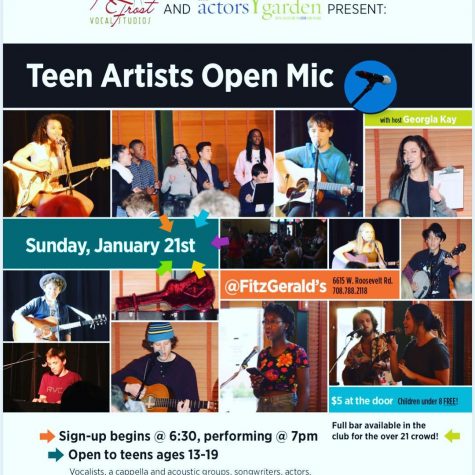
Frost and Hudson had “known of” each other for some time before officially meeting around 7 years ago through a mutual friend, who ran the music studio next to Actors Garden. Many of Frost’s students were also students of Hudson’s, so their circles inevitably connected at just the right time.
“When we finally met, we hit it off immediately,” Hudson said. “I just recognized her energy, her passion and her dedication to her students.”
At the end of each night, Hudson and Frost take to the stage to thank the audience for making it out and the performers for showing them something new. They are routinely giddy with pride, whispering soft “good jobs” as they buzz through the room as if floating on air, before reaching the microphone at the front.
“They’re both such powerhouse women,” Kay said, holding her fists in the air. “They have such big, warm personalities.”
The pair also perfectly embody and represent what it means to, so thoroughly and consistently, enjoy what you do.
“I tell my students this a lot, and it’s that you have to love [music] enough to be willing to not be famous,” Frost said. “If you really feel that you’re passionate about it, then it has to be from that place of not craving spotlight. I’m not rich, I don’t have a lot of money, but I am doing what I love.”
Frost proposed the idea of Hudson’s son, Garen, hosting, who was then a spunky 16-year-old with a deeply old-soul and balloon-sized dreams of becoming a full-time musician. He would later lead the audience in regular sing-alongs, softly crooning “Come Together” by The Beatles at the end of almost every night, before retiring in 2016 to take a gap year wherein he’d travel the world.
“Those first few [months] were so funny because he was so young,” Gigi Hudson said. “And he was still learning his craft.”
Garen Hudson remembers the experience similarly; navigating his new role as an emcee would take time, patience and care. He remembers writing entire scripts in advance, mapping out every word and thought he’d eventually communicate to his monthly listeners.
“When I was starting out, it was nerve-wracking getting up there and saying people’s names,” Hudson said. “I tended to compensate by pulling out jokes, like really crappy jokes.”
Hudson shutters to think about those early days, as most do when forced to reflect on your own clunky early teens, but even in those first several months that kicked off the rest, no one ever let him fall.
“The good thing is, everyone kind of takes care of you there,” Hudson said. “It’s a really supportive environment.”
Frost recalls a meeting she’d had with both Gigi and Garen Hudson, as well as Gigi Hudson’s husband, Dave, and her daughter, Paige. The hope was to have a very clear understanding of exactly what the open mic was and what needed to be covered and established in the very first one.
“[It was emphasized that] the most important thing that you have to do is make people feel included and welcome,” Frost said. “And I didn’t have to say another word to him about that at all.”
Like many of the young performers the open mic sees on a monthly basis, Hudson and Frost discovered their own paths pretty early on.
“I’ve been teaching [acting], let me do the math here,” Hudson pauses, and her eyes briefly drift to the ceiling of her studio. “I think I’ve been at it for 30 years now.”
After graduating from the University of Nebraska-Lincoln, “of all places!” she would quip, Hudson pursued acting, first traveling to New York City, then to Missouri, a comparatively much smaller pond. Then, upon “realizing that they don’t pay actors in Missouri,” Hudson discovered a place where she could teach children’s theater.
“I went to the director and said, ‘I don’t have a lot of teaching experience, but I do have quite a bit of theater experience, so perhaps, we could work together,’” Hudson said. “And then under her tutelage, I began teaching children’s theater, and that was it, I was hooked.”
It was as if Hudson’s dreams had shifted and morphed into something that felt completely new, and there was suddenly a much wider universe to explore. Hudson moved to Chicago, started her family and began a program through other theater companies in the area, who were in need of a children’s theater component to their lessons. Then about six years ago, Hudson branched out on her own and started Actors Garden.
“At that point, it was a very scary leap, but at the same time, there was a small, little safety net,” Hudson said. “Because I was able to bring a lot of the folks that had been with me through the other theater companies, not only my staff but families, as well.”
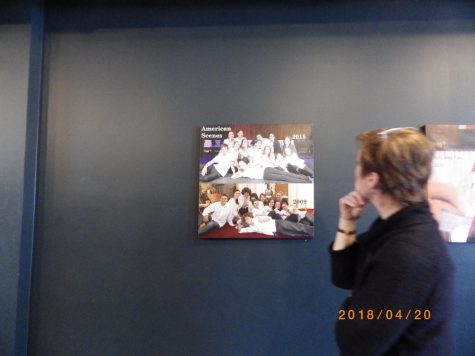
Gigi Hudson proudly reminisces about her past students at The Actors Garden, many of whom would later participate in the open mic at FitzGerald’s.
Hudson feels gratified by the work that she’s put in, the mountains she’s moved and the students that keep coming back, electric with the dreams that she also had as a young actor.
“You know, I look at some of the pictures on the wall here,” Hudson looks over at the wall to her left at a photo of a very young girl with short brown hair that’s tied back with a billowing red headband; her mouth is pressed in a small, tight-lipped smile. “She’s graduating from high school in a year.”
She then swivels to face the wall to her right where another canvas hangs. It’s a photo of a 13-year-old boy whose jaw hangs wide open, as if unattached to the rest of his face, in a goofy and delirious grin. Hudson nods towards the image.
“This guy’s 26-years-old now,” Hudson said. “And they come back or come to see the shows or come back as [camp] counselors, and this is so cheesy, but we get to watch our little seedlings grow.”
Frost first took the stage at a school talent show in third grade while she was living in Tennessee, singing “Have You Never Been Mellow?” by Olivia Newton-John, who was her personal superhero at the time. She began violin lessons the year after, and it became her primary instrument for the several years that followed.
“I didn’t start taking vocal lessons until I was about 16 or 17,” Frost said. “I knew from a very early age that that was what I wanted to do, and I’ve never wanted to do anything else.”
After pursuing musical theater throughout much of her high school career, Frost eventually attended the Indiana University Jacobs School of Music as a vocal performance major, but at the time, the major’s only field of study was opera.
“I didn’t want to be an opera singer,” Frost said. “So, on a whim, I sent an audition tape into Berklee College of Music and got in, then got a couple of scholarships out of the deal, and that was probably the best experience of my life.”
Frost first performed at FitzGerald’s, in its main club, in 2003 for a singer’s showcase, then later returned to the stage with her group, Ladies of the Canyon, who perform the music of legendary female singer-songwriters.
“I sort of inherited [the group,]” Frost said. “The woman who started it and ran it moved to L.A. and kind of gave it to me to take over.”
The group would, fairly regularly, play at a club called Martyrs in Chicago, but the club owner and the woman who’d previously fronted the group had some kind of falling out, and the rest of the ladies were left to find a new place to perform.
“The logical thought was, ‘let’s try FitzGerald’s,’” Frost said. “And Bill FitzGerald was so supportive and generous, and so we started doing the shows there.”
Frost even recalls FitzGerald allowing Ladies of the Canyon to use the club space to rehearse for free on empty Monday nights.
“[Ladies of the Canyon] had one night where we did the music of Eva Cassidy,” Frost said. “And we thought, ‘you know what? This isn’t going to fill the club, so why not do it in the music room?’”
The show completely sold out, and Frost quickly realized the potential of the sidebar space.

The FitzGerald’s iconic sidebar sign that overlooks Roosevelt Road and directs performers to their ultimate destination: the stage.
“To have young people go into a place like FitzGerald’s and perform there,” Frost said as her eyes widened, bewildered by the idea. “It’s such an iconic music venue.”
“Unbelievable musicians have walked through those doors,” Hudson said. “What a great thing to be a young person and be able to say, ‘yeah, I’m performing at FitzGerald’s tonight.’”
There had been times in the past wherein Frost and Hudson wondered if they’d be able to sustain the open mic month after month. Each third Sunday, they’d wait anxiously on the edge of their seats for people to trickle in.
“When we weren’t sure if we were going to be able to keep [the sidebar space], we entertained the notion of having it [at Actors Garden],” Hudson said. “And even though I love it here and this is my home away from home and I feel so proud of this space, I knew it wouldn’t be the same.”
FitzGerald’s felt like home from the beginning and entertaining the idea of having it anywhere else was difficult. Hudson and Frost both knew that the open mic would still mean as much, regardless of where it landed, to the people that faithfully walked through those doors each month. But it’d be different.
“Special? Yeah, well, maybe,” Hudson said. “But it would take on a totally different feeling.”
Having started so young, both Frost and Hudson feel that the arts are an essential part of a child’s life. In 2013, according to Think Progress, Chicago Public Schools laid off over 1,000 teachers, 10 percent of whom taught art or music.
“By creating, you’re making the world a better place,” Frost said. “And why would you think to take that away from kids? It makes no sense to me.”
“[Oak Park] is not without arts programming,” Hudson said. “Yet, this is a very unique niche that isn’t offered everywhere, so I like that we provide that for everyone.”
Georgia Kay runs a volunteer organization called Roses4Austin, wherein she teaches arts and crafts to young students whose school’s art programs have been cut entirely.
“It is so important for social and emotional learning,” Kay said. “It exercises a part of your mind that nothing else does in that same way.”
According to The Telegraph, one’s exposure to visual art, such as a painting or a sculpture, increases blood flow to the brain by 10 percent, which is the equivalent of staring at a person you love.
Kay feels more self-aware than her 16-year-old self, who began this journey for her, what seems like, ages ago. She feels more comfortable on stage, willing to ebb and flow with the night. She’s grown since and expanded in different directions artistically, writing new material along the way.
“Sometimes, I find myself limiting the things that I write,” Kay said. “I don’t feel like I’m as honest, because of who I know will be in the audience, like my parents and my friends, so [beyond the open mic] I’m really excited to be more open to opening up a little more.”
She’s 18 now and heading off to college in Boston once summer ends, full of wonder about what the future holds. She talks about her independence as if it’s a car that she’s driving to the clouds. She’ll be passing the host-torch in a few months and can’t quite imagine what it’ll be like to return.
“It’s just so strange to think about,” Kay said. “It feels so bizarre to revisit these spaces after you’ve taken time away from them, like going back to your grade school after being in high school, and you’re like, ‘wow, the lockers are so much smaller, and I feel so different.’”
While Kay was speaking, “My Shot” from the musical “Hamilton” began to boom loudly in the background. She paused immediately, muttered that it was distracting, shimmied to the music while her hands danced through the air and mouthed the words “I am not throwing away my shot.” When the chorus was over, she folded her hands in her lap and finished her sentence exactly where she left off.
Kay believes there’s something sacred about performing art live, that it somehow can feel like a promise made between the artist and the audience forever. In the past four years that the open mic has been alive and well, Kay feels like those moments happen all of the time, and she feels lucky to have been there for so many of them.
“That’s what’s so cool about live music and open mics; those performances only happen once,” Kay said. “So, you just gotta be there for them.”


